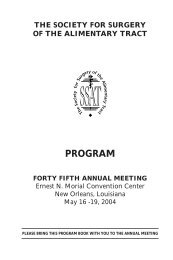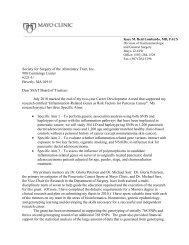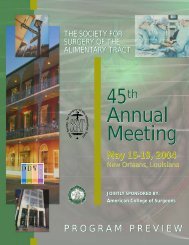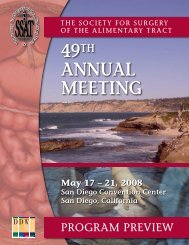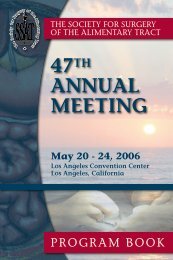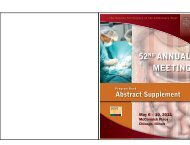51ST ANNUAL MEETING - Society for Surgery of the Alimentary Tract
51ST ANNUAL MEETING - Society for Surgery of the Alimentary Tract
51ST ANNUAL MEETING - Society for Surgery of the Alimentary Tract
Create successful ePaper yourself
Turn your PDF publications into a flip-book with our unique Google optimized e-Paper software.
THE SOCIETY FOR SURGERY OF THE ALIMENTARY TRACT<br />
<strong>51ST</strong> <strong>ANNUAL</strong> <strong>MEETING</strong> • MAY 1–5, 2010 • NEW ORLEANS, LA<br />
membership should be enlarged ra<strong>the</strong>r than restricted to a small group.<br />
The first constitution <strong>of</strong> <strong>the</strong> <strong>Society</strong> was approved that same year. The<br />
requirements <strong>for</strong> membership were:<br />
1. Fellowship in <strong>the</strong> American College <strong>of</strong> Surgeons or its equivalent;<br />
and<br />
2. Demonstrated interest in <strong>the</strong> function and disease <strong>of</strong> <strong>the</strong> alimentary<br />
tract as evidenced by fundamental research or by publication <strong>of</strong><br />
significant papers.<br />
Initially, <strong>the</strong> number <strong>of</strong> published papers was flexible, but by 1981, sixteen<br />
years later, <strong>the</strong> requirement <strong>for</strong> at least 10 publications became <strong>the</strong> law <strong>of</strong><br />
<strong>the</strong> membership committee. As a result, <strong>the</strong> society’s growth flattened.<br />
In 1984, <strong>the</strong> Board <strong>of</strong> Trustees became concerned over <strong>the</strong> lack <strong>of</strong> growth<br />
and again decided that <strong>the</strong> publication requirement should be liberalized.<br />
Dr. James Thompson, Chairman <strong>of</strong> <strong>the</strong> Board, noted that “<strong>the</strong> ascendancy<br />
<strong>of</strong> our collegial organization, <strong>the</strong> American Gastroenterological Association<br />
(AGA), to a position <strong>of</strong> great importance, many believe, dates from its<br />
adoption <strong>of</strong> <strong>the</strong> recommendation <strong>of</strong> Dr. Mort Grossman that it be an<br />
egalitarian and not an elitist organization.” Dr. Thompson urged <strong>the</strong><br />
membership to identify surgeons practicing alimentary surgery in <strong>the</strong>ir<br />
community and propose <strong>the</strong>m <strong>for</strong> membership. At this time, <strong>the</strong> only<br />
membership criteria were certification by <strong>the</strong> American Board <strong>of</strong> <strong>Surgery</strong><br />
or its equivalent, membership in <strong>the</strong> American College <strong>of</strong> Surgeons or its<br />
equivalent, and an interest in gastrointestinal surgery.<br />
In 1993, President-Elect Dr. Bernard Langer set an agenda that focused on<br />
three important issues facing <strong>the</strong> <strong>Society</strong>: first, <strong>the</strong> creation <strong>of</strong> advanced<br />
training programs in gastrointestinal surgery; second, <strong>the</strong> need to increase<br />
substantially <strong>the</strong> membership <strong>of</strong> <strong>the</strong> <strong>Society</strong> to include <strong>the</strong> vast majority<br />
<strong>of</strong> surgeons practicing alimentary tract surgery in North America; and<br />
third, an assessment <strong>of</strong> starting <strong>the</strong> <strong>Society</strong>’s own journal <strong>of</strong> gastrointestinal<br />
surgery. During his presidency, Dr. Langer convened a task <strong>for</strong>ce that recommended<br />
to <strong>the</strong> Board a campaign to aggressively recruit members, a<br />
change in <strong>the</strong> membership process to one <strong>of</strong> direct application, and <strong>the</strong><br />
creation <strong>of</strong> a trainee membership. The proposed criteria <strong>for</strong> membership<br />
were:<br />
1. A degree from a medical school acceptable to <strong>the</strong> Board <strong>of</strong><br />
Trustees;<br />
2. A license to practice medicine in <strong>the</strong> applicant’s state, providence<br />
or country;<br />
3. Certification by a board that is a member <strong>of</strong> <strong>the</strong> Board <strong>of</strong> <strong>the</strong><br />
American Board <strong>of</strong> Medical Specialties, <strong>the</strong> Royal College <strong>of</strong><br />
Physicians and Surgeons in Canada or an equivalent body; and<br />
4. An interest in surgical aspects <strong>of</strong> digestive disease. The most<br />
important part <strong>of</strong> <strong>the</strong> proposal was that applications <strong>for</strong><br />
membership could be initiated by <strong>the</strong> applicant.<br />
The result <strong>of</strong> <strong>the</strong>se changes has been a substantial increase in <strong>the</strong><br />
membership <strong>of</strong> <strong>the</strong> <strong>Society</strong> in recent years.<br />
The development <strong>of</strong> <strong>the</strong> <strong>Society</strong>’s own journal took many years. The<br />
founders <strong>of</strong> <strong>the</strong> organization wished to live in harmony with <strong>the</strong> already<br />
established surgical organizations, which precluded consideration <strong>of</strong><br />
an independent journal. After <strong>the</strong> first annual meeting, several existing<br />
journals expressed interest in publishing <strong>the</strong> <strong>Society</strong>’s papers <strong>the</strong> publication<br />
<strong>of</strong> <strong>the</strong> papers presented at <strong>the</strong> first annual meeting. Ultimately, a<br />
decision was made to publish in <strong>the</strong> American Journal <strong>of</strong> <strong>Surgery</strong>, edited<br />
by Dr. Zollinger; that journal subsequently published <strong>the</strong> papers presented<br />
at <strong>the</strong> <strong>Society</strong> <strong>for</strong> <strong>the</strong> next ten years. Only once during that period, in<br />
1965, <strong>the</strong> <strong>Society</strong> reviewed <strong>the</strong> possibility <strong>of</strong> publishing its own journal,<br />
but thought it not to be desirable at <strong>the</strong> time. In 1970, <strong>the</strong> American<br />
Journal <strong>of</strong> <strong>Surgery</strong> became <strong>the</strong> <strong>of</strong>ficial journal <strong>of</strong> <strong>the</strong> <strong>Society</strong>, with all<br />
members subscribing to <strong>the</strong> journal as part <strong>of</strong> <strong>the</strong>ir membership.<br />
The issue resurfaced again in 1993 as one <strong>of</strong> Dr. Langer’s three important<br />
decisions facing <strong>the</strong> <strong>Society</strong>. The issue became part <strong>of</strong> <strong>the</strong> agenda <strong>of</strong> <strong>the</strong><br />
special task <strong>for</strong>ce convened during his presidency. In response to <strong>the</strong><br />
report <strong>of</strong> <strong>the</strong> task <strong>for</strong>ce, <strong>the</strong> Board appointed a Publication Committee,<br />
GENERAL<br />
INFORMATION<br />
16<br />
17



